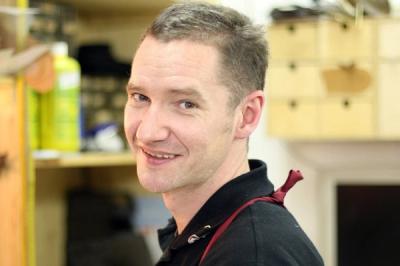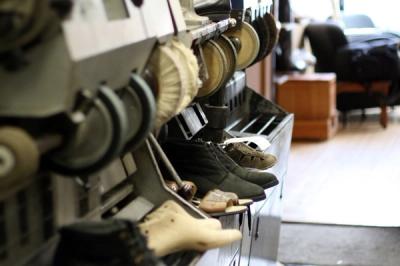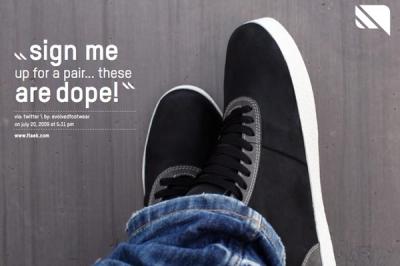Flaek Footwear Interview
Just under three months ago, two German university students (Oliver and Sven) banded together through a mutual appreciation of sneakers to brainstorm a mind-bending thesis idea. After becoming disillusioned with the growing number of retro re-issues and lack of heart within the bigwig footwear companies, the two fellas decided to create their own sneaker brand, . Little did they know, this venture would take on a life of its own in the form of their first silhouette, the kaalen hi. Keeping heads up to date with entries, the team exposed the step-by-step design process of the brand, finally revealing the tricks and trades of DIY construction. We were blown away by the entire concept of flaek, so we hit up the lads to get the goss on the flaek block!
Hey fellas, tell us a little about yourselves and how you met?
Oliver: I'm a 27 years old media design student, hailing from Fulda (near Frankfurt) in Germany. Before my studies I did an apprenticeship in media design and worked in some online design agencies. We met each other at the beginning of our design studies and soon recognized that we were both addicted to sneakers. I have been blogging about sneakers for the last two or three years on the German sneaker website .
Sven: I'm 28 years old and from Oldenburg in the north of Germany (near Bremen). I'm at the same uni as Oliver. Before I started media design in Ravensburg I worked for the German distribution of Felt bicycles. From working with a host of labels over that time, I became interested in starting my own brand. There was never any doubt that, considering my passion for kicks, that it would be a sneaker label. It really was a remarkable coincidence meeting Oliver in Ravensburg, which gave me the sign to start flaek. As they say, it was a stroke of good fortune.
Germany has such a rich heritage when it comes to sneakers (adidas and Puma anyone!!). How is the scene these days? Are you seeing a trend towards low fi kicks, with an emphasis on simplicity rather than branding?
We always maintain a low profile regarding ‘the scene'. We think there is a trend towards low fi sneakers, but it's not coming from Germany (not yet). In the last few years some really cool, small brands came up, especially from Scandinavia, which developed new, good looking low profile styles. They all did a great job and developed alternatives to the retro models on the market.
How did the concept for flaek come about?
Designing our own sneaker has always been a dream for both of us. During our studies, we often worked together on projects that we tried to link with the subject ‘sneakers'. For example, in our second year at school we produced the Sneakerized project. It was going to be impossible for us to work on a thesis together, so we decided we would try and produce our own sneaker brand instead.
You've documented the whole process on your blog, which would seem to be part and parcel with your thesis - have you ever been worried throughout the whole process that someone would jack your ideas?
Not really. I even think the documentation helped us to avoid the consequences of a jacked idea. Of course, you can steal the design, copy the sneaker or the material selection, but you can't copy the story behind flaek. It would just be another copycat without any passion.
So you're not trying to document this as a 'how to' guide then?
No, not at all. We didn't want to create a step-by-step guide on ‘how to create your own sneaker brand'. We've always been bothered by the fact that there isn't that chance to talk to larger sneaker brands, there's no sense of openness there. We miss the personality big brands lost with the years of growing, so we had the idea of sharing the whole process, the whole story behind the brand flaek with people who were interested in it. We wanted to create a transparent brand from sneaker-heads for sneaker-heads without the marketing agency crap. After two months, we can definitely regard it as the best decision to blog about the whole project. We got so much feedback on the daily, which really influenced our work and motivated us to continue this way.
How does creating a sneaker brand correlate with a thesis in media design?
It actually correlates quite well. Because our studies in design covered a relatively wide field of applications, we feel well prepared to plan and realize a lot of the tasks ourselves - from the concept design, to the product, photography and print media and web design. In the end only the handcrafting of the sneaker itself had to be done by our shoemaker Frank.
Were you overwhelmed by the challenges you had to face in order to get this off the ground?
There was definitely no sophisticated plan in the beginning, Looking back, we took a certain risk by letting our thesis depend on our first steps of setting up a sneaker brand. And even though we started the whole thing optimistically and with good self-confidence, none of us would have expected it to run as smoothly as it did. What helped was the constant feedback that we received from our lecturers as well as the readers of the blog. Their affirmation pushes us to take the project to the next level.
What has been the most difficult part of the whole process to date?
The most difficult part was the coordination of the production with the shoemaker. There can never be too much talk and discussions on the details - and believe us, there are a lot of details on this shoe that we had to think about. Certain aspects of product and production were totally self-evident to us as the creators but had to be reviewed from the technical side of things. The most important and most challenging job was the communication during the manufacturing process. Obviously the geographical distance of 900 km between us and our shoemaker was not very helpful in this stage of the project as we could never quickly drop by to check out the latest status. Saying that, we were quite insecure about the outcome until we finally held the finished shoe in our hands. Luckily it all worked out perfectly fine - respect and praise to our craftsman Frank the shoemaker!
How did you source the perfect materials to use for the shoe? Was there a lot of trial and error involved?
Quite the contrary! Thanks to Frank we were able to complete the choice of material in very short time. With his wealth of experience he was able to give us great advice and we are totally confident and happy with the fabrics we used. The leather is probably as expensive as the complete production of some industrial manufactured sneakers but quality has always been on top of the list for us.
Talk us through the design of your first shoe - the kaalen hi...
The concept of the kaalen hi is based on two very basic factors: Simplicity and hi-end material. We wanted to come up with a timeless, puristic piece of shoe - without flashy, big branding on the inside or the outside.
Do you think DIY (do it yourself) may be the way of the future?
We do not want to make any bold predictions here but we do believe that next to the established big brands there should be room for a number of smaller labels to generate relevance in the market. As long as the big guys keep resting themselves on retro fashion we see enough reasons that speak for such development. Boutique brands will have space to push innovations and new ideas and should be able to find their niches on the shelves without risking too much. And thanks to the endless possibilities of the Internet, chances to promote yourself and your brand are better than ever.
From a media design stand point - have you worked out a campaign to tie in with the release of your brand?
Absolutely, as this is one of the most essential parts of our thesis. We've already posted the first layouts of posters on our blog. For the theme, we went away from simply displaying the shoe itself or using model poses that have been seen over and over again. Instead, we came up with the idea to photograph the sneakers solely from the wearer's point of view. The observer of the image is in the position to see the shoes on him - or herself. In place of any advertising claim you will find blog comments, emails or tweets in the poster drafts that users have sent us as feedback on the kaalen hi. This emphasizes our main principle once again: We are not aiming at creating an illusionary world in which stars, models and athletes wear our sneaker, it's more for regular people with taste and style.
Will you continue with the development of flaek once the thesis is over? Will we ever see flaek hit the stores?
At this point it is hard to tell if flaek sneakers will ever be available in any shop. But we will definitely do our very best to pursue this goal and have at least a small production run or limited edition made. Should we be able to let this dream come true, you guys will be the first to know.
What's the most important lesson you have learnt trying to start your own brand?
Follow your dreams and try to achieve what you are wishing for. You can do it - if you are really willing to work on it. Even if there will never be any regular production, we have our own sneaker now! This alone was worth all the effort.
Thanks guys!
































